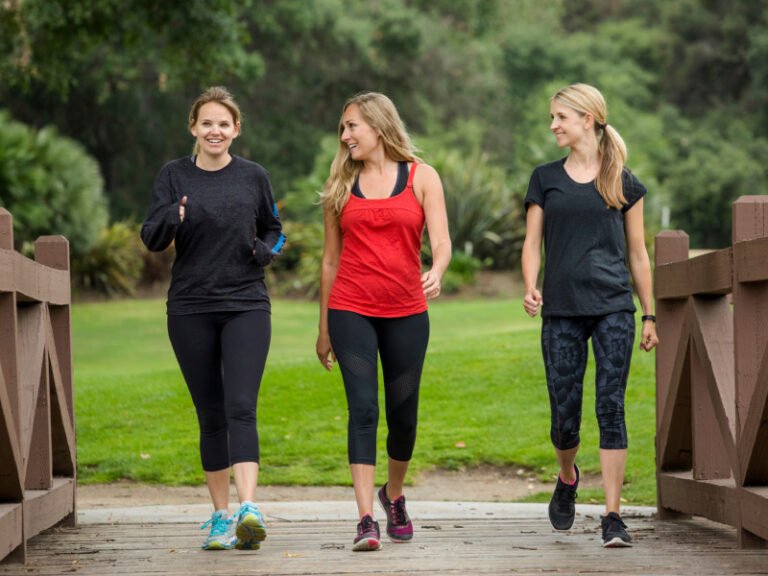A walking workout is often used by someone who wants to become moderately more physically active and is ideal for people of all ages and fitness levels. Walking is just as good as any other exercise, and setting yourself a goal to complete a “walking workout” can be more motivating than walking here and there all day.
Completing a “walking workout,” whether it’s outdoors or on the treadmill, can aid in weight loss and provide health benefits such as reducing stress and anxiety, and improving mood and general feelings of well-being. For those who don’t like going to the gym, a lower-intensity walking workout may seem more appealing and may not leave you feeling too tired to do other exercises.
Where do I start with a walking workout routine?
An hour of light to moderate walking per day is ideal for walking training. Walking at a moderate pace of 3 mph equates to an average of 6,000 steps per hour, so you can set a step goal of 6,000 steps per day. Breathing in through the nose and out through the mouth can help moderate a steady heart rate and help you stay calm and in control.
For an outdoor walking workout, it’s a good idea to set a route and record your activity on your phone or smartwatch, as this can show how many calories you’re burning and why you don’t always have to go to the gym to work out. Walking for just one hour each day can reduce the rate of depression, boost your mood, give you energy and helps reduce stress– according to research.
When to choose a walk workout over a HIT workout?
Higher impact workouts are more prone to injury to joints such as hips, knees and ankles, and can also increase heart rate. For someone who is recovering from an injury, has joint problems, or is fairly new to exercise, starting with a low-intensity walking workout is much better. For someone who may have a heart condition, it’s important to stick to low-intensity activity to ensure you’re not putting too much strain on your heart. Low-intensity exercise also puts less stress on your body and reduces the need for rest days, helping you stay consistently active. Also, choose a lower intensity to avoid possible injury or high heart rate.
Older adults are naturally more vulnerable to developing heart disease. The Center for Disease Control recommends that healthy adults over age 65 should aim for 150 minutes of low- to moderate-intensity cardiovascular activity once a week.
Step 1 – Warm-up
Before any form of exercise, you should always warm up. This consists of 5-10 minutes of light stretching exercises, from leg swings, arm circles and head rotations. An initial brisk walk can also be done for a few minutes to gradually increase your heart rate.
Step 2 – Set your goal
Depending on the results you would like from your walking training. You can set a goal of desired intensity and duration. For beginners, start with a 20 to 30 minute walk at a moderate pace. You can then increase your duration or intensity depending on how comfortable you feel.
Step 3- Choose a route
Determining a route will help you start your walking routine. Whether it’s through your local park, along the beach or through the woods, choosing a route with nice scenery always helps your walk feel enjoyable.
Top expert tip: remember to consider any safety factors that could potentially get in your way. You may want to take a test ride to make sure the ride is right for you.
Step 4- Record your activity
Your activity log will show you how many calories you’ll burn with your workout. Whether you’re using a smartwatch or your smartphone, you can track your distance, time, pace and calories burned. Tracking your progress can also help you stay motivated and set new goals for more rides.
Step 5- Remember fuel and hydration
Just because a walking workout is a lower-intensity form of exercise doesn’t mean you can skip it pre-fuel and hydration. Have a balanced meal that is high in carbohydrates, some protein and low in fat. Carbohydrates are the preferred energy source for working muscles during exercise. During your walk, carry a bottle of water with you and take frequent sips
Step 6 – Maintain proper posture
Maintaining a proper posture during your ride is important to avoid any discomfort or injury to the spine. To do this, keep your spine straight to avoid any slouching and try to engage your core muscles. Also maintain a consistent breathing technique, inhaling through your nose and exhaling through your mouth.
Step 7- Insert spaces
If you want to add a higher intensity to your workout routine after a few weeks, you can incorporate intervals. Try walking at a faster pace for a certain distance or time. Then switch to a slower pace to recover.
Top expert tip: repeat intervals during your walk to challenge your cardiovascular system.
LivingBetter50 is a magazine for women over 50, offering over 50 free download magazines for women of the spirit!
